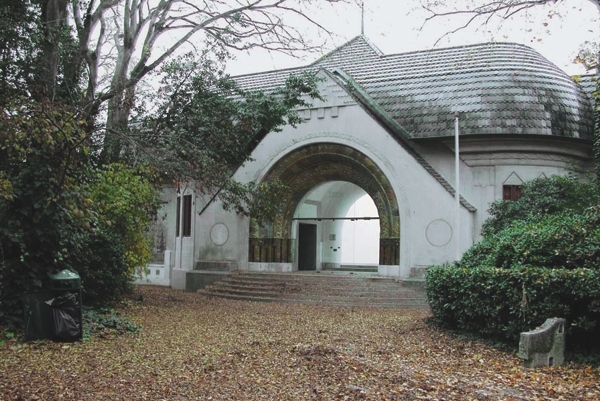Ephemeral Architecture in Central-Eastern Europe
Ephemeral Architecture in Central-Eastern Europe in the 19th and 20th centuries
Budapest, 28-29th November 2013
A two days conference organized by The Research Centre for the Humanities, Institute of Art History, Hungarian Academy of Sciences in cooperation with CentrArt Association – New Workshopfor Art Historians
Conference hall of Budapest City Archives
(H-1139 Budapest, Teve str. 3-5.)
1st Day ŌĆōThursday, 28th November 2013
8:00-9:00 Registration
9:00 Welcome speaches
Mikl├│s Sz├®kely (Organizer of the conference),
Istv├Īn Kenyeres (Director General of Budapest City Archives),
J├│zsef Sisa (Director of Institute of Art History, Research Centre for the Humanities, Hungarian Academy of Sciences)
9:30-10.00 Keynore Speech: Anna Korndorf, Ekaterina Viazova (Department of Russian Art and Architecture, State Institute of Art History)
Utopia of Transparency: 19th-Century Exhibition Pavilion Architecture as Mythological Project
10.00-11.00. Section1. Architecture, origins, materials.Chair: J├│zsef Sisa
Dr. Gianenrico Bernasconi (Institut f├╝r Popul├żre Kulturen, Universit├żt Z├╝rich)
The tentroom
Magdalena Żakowska (Central and Eastern Europe Department, Faculty of International and Political Studies, University of Łódź)
Austrian and Russian National Pavilions as Mediums of National Self-Representations at the Vienna World Exposition 1873
11.00-11.30CoffeeBreak
11.30-12.50. Section2. The Hungarian Millennium at the Crossroad of Nation Buildings Chair: P├Īl L┼ævei
Paolo Cornaglia PhD (Turin Polytechnic, Department of Architecture and Design)
Franczia ├®tterem: the French restaurant by Karman& Ullmann in the National Hungarian Exhibition of 1896
Dragan Damjanovi─ć PhD, doc.(Art History Department, Faculty of Humanities and Social Sciences, Zagreb University)
Croatian Pavilions at the 1896 Millennium Exhibition in Budapest
Mikl├│s Sz├®kely PhD (Institute of Art History, Research Centre for the Humanities, Hungarian Academy of Sciences)
Representation reduced and exported: The re-setting of the Main Historical group of the Millennium Exhibition at the 1900 Paris Universal Exhibition
12.50-13.50Lunchbreak
13:50-15.30. Section3. ŌĆ×Western Venues, Eastern Nations.ŌĆØChair: Mikl├│s Sz├®kely
Cosmin Tudor Minea MA (Central European University, Budapest)
Creating a National Architecture : the Pavilions of the Balkan Countries at Two 19th Century Universal Exhibitions
Dr. Aleksandar Ignjatovi─ć (University of Belgrade)
Competing Byzantinisms: Architectural Imagination of the Balkan Nations at the Paris World Exhibitionin 1900
├ügnes Sebesty├®n (University of Bern, Institute of Art History)
The Pavilion of Bosnia and Herzegovina at the Universal Exposition of 1900 in Paris: a Case Study
Cristiana Volpi PhD (University of Trento, Department of Civil, Environmental and Mechanical Engineering)
The Hungarian Pavilion at the Venice Biennale. Tradition and modernity during one century
15.30-16.00 Coffeebreak
16.00-17.20. Section4. ŌĆ×Eastern Venues, Eastern Nations.ŌĆØ Chair: Dr. Aleksandar Ignjatovi─ć
Deniz T├╝rker PhD candidate (Harvard University, Center for Middle Eastern Studies and the History of Art and Architecture Department&Dumbarton Oaks Tyler Fellow)
The ŌĆśOttomanŌĆÖ Pavilions at the Turn-of-the-Century
Silvija Grosa, Dr. art (Art Academy of Latvia)
Between National Romanticism, Modernist Tendencies and Traditionalism ŌĆō Two Exhibitionsin Riga at theTurn of the 20th Century
Weronika Grzesiak, MA (Art History Institute, Jagiellonian University inCracow)
National Representations on the General Provincial Exhibition (Lviv 1894)
ŌĆā
2nd Day ŌĆōFriday 29th November 2013
9:00-9.30 Keynore Speech: ├ügnes Anna Sebesty├®n (Archaeolingua Foundation, Budapest)
Shaping Ephemeral Architecture by the Media
9.30-9.50. Tam├Īs Cs├Īki (Budapest City Archives)
Ephemeral architecture of the Metropolis: plans for urban pavilions by Bertalan Árkay from the 1920s
9.50-10.20 Coffeebreak – Meanwhile: Optional guided visit in the storage of Budapest City Archive exclusively for conference speakers by Tam├Īs Cs├Īki.
10.20-11.40. Section6. Rise, Fall and Shift of Ideologies II.Chair:
Marta Filipov├Ī, PhD (University of Wolverhampton)
From the national village house to the international expo pavilion: ephemeral ideologies?
Mgr. Petra Nov├Īkov├Ī (Palack├Į University of Olomouc, Czech Republic, Department of the History of Art)
State propaganda at the background of the Czechoslovak temporary exhibition installations at LaTriennale di Milano, 1923-1968
Aleksandra Stamenkovi─ć MA (Faculty of Philosophy, University of Belgrade, Department for Art History)
Ephemeral Structure of National Pavilions on World Fairs 1918-1941
11.40-12.40 Lunchbreak
12:40-14.00. Section7. Bridges over the Iron Curtain I.Chair: P├Īl Rito├│k (Hungarian Museum of Architecture)
Nikolas Drosos (Graduate Center, City University of New York, 2013-15 Chester Dale Fellow, Center for Advanced Studyinthe Visual Arts, National Gallery of Art, Washington)
Modernism with a Human Face: Communist Europe atthe 1958 World Fair
P├®ter Haba (Lecturerat Department of Design and Art History, Institute of Theoretical Studies, Moholy-Nagy University of Art and Design, Budapest)
The rise of aluminium, Pavilionsby ALUTERV inthe Budapest City Park trade fair centre
Mirna Me┼Ītrovi─ć, DipArch MS, Aleksander Laslo DipArch (Development Department of Zagreb City Administration)
Fair ground as Geopolitical Playground: Zagreb International Trade Fair and Cold War Circumstances
14.00-14.30 Coffeebreak
14.30-15.50. Section8. Bridges over the Iron Curtain II Chair: Marta Filipov├Ī
Katarzyna Cytlak, PhD (Universidad Nacional de San Martin, Centro de Estudios sobre los Mundos Eslavos y Chinos, Buenos Aires)
The American Pavilionforthe International Fair Trade in Poznan, 1957: Richard Buckminster Fuller’s Legacy in Central Europe
Doc. ing. arch. Radom├Łra Sedl├Īkov├Ī, CSc.(National GalleryinPrague, curator of thecollection of Architecture, Praguetechnical University, Faculty of Civil Ingeneering, department of Architecture)
Two czecoslovak pavilons / two different ideological fates
Lara Slivnik PhD (University of Ljubljana, Faculty of Architecture, Ljubljana)
Architecture, Competition, Pavilon: Yugoslav Pavilion at Montreal Expo 67
15.50-16.20 Coffeebreak
16:20-18:00. Section9. Contemporary Reception of Ephemerity. Chair: Hajnalka Somogyi (Ludwig Museum ŌĆō Museum of Contemporary Art)
Helena Postawka-Lech, M.A.(International Cultural Centre in Krakow, Institute of Art History, Jagiellonian University (Krakow)
Papier-m├óch├®hammer and sickle. Decorations and temporary architecture of official gatherings, parades and festivals in Krakow between 1968 and 1989
Dr. Ayse Nur Erek(Yeditepe University, Humboldt University)
The Afterlife of Ephemeral Architecture: The Pavilion in the Context of a Contemporary Art Exhibition
Dr. Bahar Beslioglu (Faculty of Architecture at M.S.G.S.U, Istanbul)
The Pavilion in the Context of a Contemporary Art Exhibition
Dr. Roula Matar-Perret PhD (Universit├®Rennes 2 / ENSA Paris LaVillette)
David MaljkovicŌĆÖs attempttore animate SambitoŌĆÖs pavilion in Zagreb
18:00 Closing remarques
3rd Day
9:00-10.30 Guided walk in Budapest City Park
11:00-12:30 Visit tothe Museum of AppliedArts

Hungarian Pavilion at the Venice Biennale
